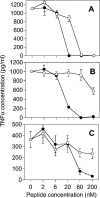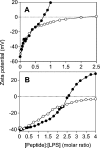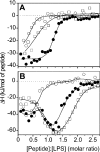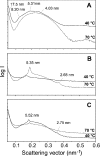Enhancement of endotoxin neutralization by coupling of a C12-alkyl chain to a lactoferricin-derived peptide
- PMID: 15344905
- PMCID: PMC1134681
- DOI: 10.1042/BJ20041270
Enhancement of endotoxin neutralization by coupling of a C12-alkyl chain to a lactoferricin-derived peptide
Abstract
Antibacterial peptide acylation, which mimics the structure of the natural lipopeptide polymyxin B, increases antimicrobial and endotoxin-neutralizing activities. The interaction of the lactoferricin-derived peptide LF11 and its N-terminally acylated analogue, lauryl-LF11, with different chemotypes of bacterial lipopolysaccharide (LPS Re, Ra and smooth S form) was investigated by biophysical means and was related to the peptides' biological activities. Both peptides exhibit high antibacterial activity against the three strains of Salmonella enterica differing in the LPS chemotype. Lauryl-LF11 has one order of magnitude higher activity against Re-type, but activity against Ra- and S-type bacteria is comparable with that of LF11. The alkyl derivative peptide lauryl-LF11 shows a much stronger inhibition of the LPS-induced cytokine induction in human mononuclear cells than LF11. Although peptide-LPS interaction is essentially of electrostatic nature, the lauryl-modified peptide displays a strong hydrophobic component. Such a feature might then explain the fact that saturation of the peptide binding takes place at a much lower peptide/LPS ratio for LF11 than for lauryl-LF11, and that an overcompensation of the negative LPS backbone charges is observed for lauryl-LF11. The influence of LF11 on the gel-to-liquid-crystalline phase-transition of LPS is negligible for LPS Re, but clearly fluidizing for LPS Ra. In contrast, lauryl-LF11 causes a cholesterol-like effect in the two chemotypes, fluidizing in the gel and rigidifying of the hydrocarbon chains in the liquid-crystalline phase. Both peptides convert the mixed unilamellar/non-lamellar aggregate structure of lipid A, the 'endotoxic principle' of LPS, into a multilamellar one. These data contribute to the understanding of the mechanisms of the peptide-mediated neutralization of endotoxin and effect of lipid modification of peptides.
Figures








Similar articles
-
Molecular basis for endotoxin neutralization by amphipathic peptides derived from the alpha-helical cationic core-region of NK-lysin.Biophys Chem. 2010 Aug;150(1-3):80-7. doi: 10.1016/j.bpc.2010.01.009. Epub 2010 Jan 29. Biophys Chem. 2010. PMID: 20153101
-
Mechanism of interaction of optimized Limulus-derived cyclic peptides with endotoxins: thermodynamic, biophysical and microbiological analysis.Biochem J. 2007 Sep 1;406(2):297-307. doi: 10.1042/BJ20070279. Biochem J. 2007. PMID: 17501719 Free PMC article.
-
Effect of the hydrophobicity to net positive charge ratio on antibacterial and anti-endotoxin activities of structurally similar antimicrobial peptides.Biochemistry. 2010 Feb 9;49(5):853-61. doi: 10.1021/bi900724x. Biochemistry. 2010. PMID: 20058937
-
Mechanisms of endotoxin neutralization by synthetic cationic compounds.J Endotoxin Res. 2006;12(5):261-77. doi: 10.1179/096805106X118852. J Endotoxin Res. 2006. PMID: 17059690 Review.
-
Inhibition of Lipopolysaccharide- and Lipoprotein-Induced Inflammation by Antitoxin Peptide Pep19-2.5.Front Immunol. 2018 Jul 26;9:1704. doi: 10.3389/fimmu.2018.01704. eCollection 2018. Front Immunol. 2018. PMID: 30093904 Free PMC article. Review.
Cited by
-
Antimicrobial peptides and endotoxin inhibit cytokine and nitric oxide release but amplify respiratory burst response in human and murine macrophages.Cell Microbiol. 2005 Sep;7(9):1251-62. doi: 10.1111/j.1462-5822.2005.00549.x. Cell Microbiol. 2005. PMID: 16098213 Free PMC article.
-
Biophysical analysis of the interaction of granulysin-derived peptides with enterobacterial endotoxins.Biochim Biophys Acta. 2007 Oct;1768(10):2421-31. doi: 10.1016/j.bbamem.2007.05.001. Epub 2007 May 22. Biochim Biophys Acta. 2007. PMID: 17555705 Free PMC article.
-
Branched Peptide, B2088, Disrupts the Supramolecular Organization of Lipopolysaccharides and Sensitizes the Gram-negative Bacteria.Sci Rep. 2016 May 13;6:25905. doi: 10.1038/srep25905. Sci Rep. 2016. PMID: 27174567 Free PMC article.
-
Antibacterial activity of ultrashort cationic lipo-beta-peptides.Antimicrob Agents Chemother. 2009 May;53(5):2215-7. doi: 10.1128/AAC.01100-08. Epub 2009 Feb 23. Antimicrob Agents Chemother. 2009. PMID: 19237652 Free PMC article.
-
Primary and Secondary Binding of Exenatide to Liposomes.Biophys J. 2020 Feb 4;118(3):600-611. doi: 10.1016/j.bpj.2019.12.028. Epub 2020 Jan 3. Biophys J. 2020. PMID: 31972156 Free PMC article.
References
-
- Vogel H. J., Schibli D. J., Jing W., Lohmeier-Vogel E. M., Epand R. F., Epand R. M. Towards a structure–function analysis of bovine lactoferricin and related tryptophan- and arginine-containing peptides. Biochem. Cell Biol. 2002;80:49–63. - PubMed
-
- Baynes R. D., Bezwoda W. R. Lactoferrin and the inflammatory response. In: Hutchens T. W., Lönnerdal B., Rumball S., editors. Lactoferrin: Structure and Function. New York: Plenum Press; 1994.
-
- Wakabayashi H., Takase M., Tomita M. Lactoferricin derived from milk protein lactoferrin. Curr. Pharm. Des. 2003;9:1277–1287. - PubMed
-
- Zähringer U., Lindner B., Rietschel E. T. Molecular structure of lipid A, the endotoxic center of bacterial lipopolysaccharides. Adv. Carbohydr. Chem. Biochem. 1994;50:211–276. - PubMed
Publication types
MeSH terms
Substances
LinkOut - more resources
Full Text Sources
Other Literature Sources
Medical

